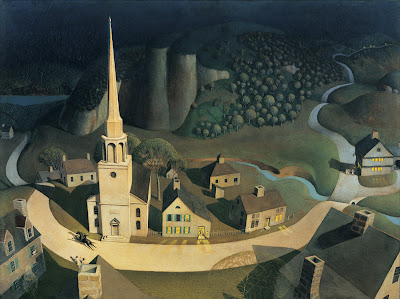Today's Almanac--April 18, 2010

Grant Wood painted this vision of Paul Revere’s ride in 1931.
April 18, 1775 was immortalized by Henry Wadsworth Longfellow as the date of Paul Revere’s Ride. But Revere, a prominent Boston silver smith and a leading member of the Sons of Liberty, was only one of dozens of couriers that spread the word that night and the following morning of the Redcoat advance from the city. Troops had been quartered in Boston since the port was closed by the Crown in retaliation for the Boston Tea Party in 1773. Revere had been among the men who boarded the ships in semi-disguise as Indians. It was not his first connection to the Patriot movement. His shop had been producing political engravings protesting the Stamp Act in the 1760’s and he was a close associate of Dr. Joseph Warren. Tensions mounted in the city culminating in a clash between armed troops and Patriot rowdies that became known as the Boston Massacre of 1770 which Revere recorded in an engraving that both stirred passions and was accurate enough in the placement of the victims of the shooting to be used in evidence in the trial of the British soldiers involved. When Warren organized the Committee on Public Safety, Revere was a leading member. This organization, which has been described as the first American intelligence operation, set up networks to monitor and report on British military operations and developed a system of couriers. Revere, leaving his shop mostly in the hands of his son, immersed himself in this work and often rode courier with reports from the Committee of Correspondence to New York. As conditions in the city grew worse, militias in the country side began drilling and assembling arms. Under British law these militias were perfectly legal-in fact all able bodied adult males were expected to be enrolled in the militia to act in defense of the colony or to be called to service by the Royal Governor. But the regular drilling, instead of yearly “muster days,” alarmed the authorities. As did the fact that John Hancock and other wealthy merchants were buying arms and powder. When the British learned that a significant armory was at Concord, they determined to seize. Despite attempts at secrecy, the Army’s intentions were quickly discovered by the Patriot intelligence network. What they didn’t know was whether troops would advance by land across the narrow neck connecting the city to the mainland, or opt to cross the Bay by boat. Revere himself set up the signal system in the bell tower of the Old North Church, an Anglican church with Tory sympathies but whose steeple could easily be seen across the bay and which had Patriot sexton. Revere crossed the bay by boat to Charlestown. Meanwhile another rider, William Dawes set out across the Boston Neck, getting passed the sentries posted to stop such messengers by pretending to be drunk. When Revere spotted two lamps in the Church tower, signifying a boat crossing of the bay, he sped off from Charleston on a borrowed horse. Both he and Dawes alerted the country side with the word “The Regulars are out,” not the “British are coming” for the simple fact that at the time New Englanders still considered themselves British. As the two dispatch riders converged on Lexingon from different directions they alerted other riders and messengers, probably 40 or more in all, who fanned out over the country side. By relay, the word was passed as far as New Hampshire by morning. Revere dodged a Redcoat patrol on the road to Cambridge and was forced to detour through Medford. Dawes took a round-about route through Roxbury. Revere arrived in Lexington about midnight and Dawes not long after. They found Hancock and Sons of Liberty leader Sam Adams. After conferring for some time the two men set off to Concord with Dr. Samuel Prescott. The three riders were intercepted by a patrol at Lincoln. Dawes lost his horse but escaped on foot back to Lexington. Revere was captured. Prescott jumped a stone wall and galloped of to Concord where he delivered the vital message the armory. Marched back toward Lexington with Revere at gun point, a rattle of musketry in the distance alarmed the officer in charge who took Revere’s horse and galloped to the scene releasing him on foot. Revere scampered cross country to Dr. Clark’s house where he found Hancock and Adams. Hancock wanted to stay for the fight, but Revere convinced the men that they were too valuable to the cause to be captured and helped them get on their way. When he discovered that Hancock had inadvertently left behind a chest containing important Patriot papers, he rescued the documents while making his own escape. The handful of Minute Men assembled hastily in the open on Lexington Green was no match for British Regulars. But a significant force was raised to repel the advance at Concord Bridge and harry the Redcoats bloody retreat all the way back to Boston. Although Revere’s role in alerting the countryside was known, it was not particularly well celebrated until Longfellow took pen to paper in January of 1861. He was inspired as much by contemporary events as by historical ones. With the election of Abraham Lincoln, civil war was brewing. Longfellow hoped his poem itself would be a warning to his countrymen of the new danger.